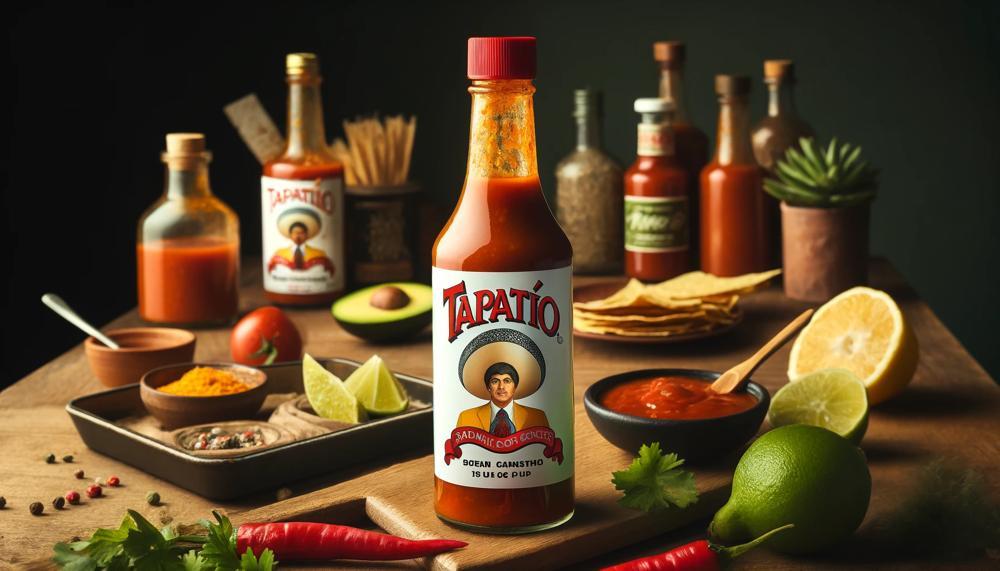Do you know Tapatio hot sauce doesn’t need refrigeration? That’s right! It stays fresh and tasty even when stored at room temperature.
The secret lies in its vinegar base and high salt content. These elements stop bacteria and microbes from growing. Vinegar’s acidity and the capsaicin in peppers ensure Tapatio stays stable on your counter.
Although not necessary for safety, refrigerating hot sauce has benefits. It keeps the sauce’s quality high and its flavor on point. Since hot sauces vary, always check the label for storage tips.
So, does tapatio need to be refrigerated?
Although it’s not necessary, some people advise refrigerating Tapatio hot sauce within two years after purchase for best taste. Tapatio is shelf-stable because to its high vinegar and salt content and includes red peppers, water, salt, spices, garlic, acetic acid, xanthan gum, and sodium benzoate as a preservative. Nonetheless, keeping hot sauce chilled can:
- Maintain appearance: If kept unrefrigerated, certain spicy sauces, such as Tabasco, eventually lose their color.
- Maintain quality: Even unspoiled spicy sauce may lose its flavor with time.
Hot sauce can keep its freshest for up to six months at ambient temperature, but it will keep longer in the refrigerator, according to the USDA’s FoodKeeper app. Once opened, chilled hot sauce usually keeps for a year or two.
Contents
Key Takeaways:
- Tapatio hot sauce does not need to be refrigerated for safety reasons.
- Storing Tapatio hot sauce at room temperature will not affect its freshness or flavor.
- Refrigerating hot sauce can help prolong its freshness and maintain its flavor for a longer period of time.
- Hot sauces have varying shelf lives, so it is important to check the packaging for specific storage instructions.
- The choice of whether to refrigerate hot sauce ultimately comes down to personal preference and desired freshness.
Factors to Consider for Hot Sauce Storage
Storing Tapatio hot sauce doesn’t require refrigeration. But, there are key points worth noting for hot sauce storage. Unlike Tapatio, some sauces like Tabasco might change color if not kept cold. This doesn’t mean they’ve gone bad though.
Each hot sauce has its own shelf life. It’s smart to look at the packaging for guidelines. Cholula is best within six months after opening. Tapatio, on the other hand, lasts up to two years at room temp.
While not essential for safety, chilling your sauces does keep them tasting fresh longer. Refrigerating your hot sauces is a good step for preserving quality.
Storing All-Natural Hot Sauces

Storing natural vinegar-based hot sauces like Tapatio needs some simple rules. These rules will keep your hot sauce fresh and tasty.
Hot sauces with vinegar, like Tapatio, are okay to keep at room temperature. The acid in vinegar and the salt create a bad place for bacteria. So, you don’t need to refrigerate these sauces.
To know if you can store your hot sauce without refrigeration, check its ingredients. If vinegar is the first one, room temperature storage is generally safe.
| Vinegar-based Hot Sauces | Storage Guidelines |
|---|---|
| Tapatio | Store at room temperature |
| Tabasco | Store at room temperature to prevent color change |
| Cholula | Store at room temperature, use within 6 months |
| Oil-based hot sauces | Refrigerate to maintain freshness |
| Fruit-based hot sauces | Refrigerate for optimal storage |
Always check the manufacturer’s instructions for storage. The package or website often has special storage tips.
Hot sauces without much vinegar should be kept cold. The same goes for sauces based on oil or fruit. They need the fridge to stay fresh.
Salsas and chutneys should also be refrigerated. This keeps them safe and extends their life.
Knowing how to store different hot sauces helps keep them delicious for a long time.
Refrigerating Hot Sauces for Freshness
Put your hot sauces in the fridge to keep them fresh and tasty for longer. Even with preservatives, time, oxygen, and light can still affect their flavor and strength. Remembering this can help avoid bacterial growth.
Hot sauce kept out can react with oxygen and change in color, flavor, and quality. This is called oxidation. Refrigeration can slow this down, keeping your hot sauce fresh.
Refrigeration slows down the oxidation process and helps maintain the fresh flavor of hot sauce.
The USDA’s FoodKeeper app says to refrigerate hot sauce for the best freshness. At room temperature, hot sauce stays good for up to six months, but in the fridge, it can last one to two years after opening.
Store hot sauce in the fridge for the best taste over time. It keeps tangy or spicy sauces great. Refrigeration keeps the taste and quality at its best.
| Benefits of Refrigerating Hot Sauce | |
|---|---|
| Preserves freshness | Helps maintain the fresh flavor of hot sauce for a longer period |
| Slows down oxidation | Reduces changes in color, flavor, and overall quality caused by the oxidation process |
| Extends shelf life | Allows hot sauce to maintain its peak flavor for one to two years once opened |
Refrigerating hot sauce isn’t needed for safety since vinegar and salt stop bacteria. But it’s a good choice to keep your sauce fresh and flavorful for longer.
Lastly, we’ll sum up the key points and look at different ways to store hot sauces.
Conclusion
Tapatio hot sauce doesn’t have to be in the fridge for safety. But, putting it in can help keep its freshness and taste, especially if you plan to use it over a long time. The vinegar and salt in Tapatio stop bacteria from growing.
The decision to refrigerate Tapatio or other hot sauces is up to you. It depends on how fresh you want the sauce to taste. Some people put their hot sauce in the fridge to keep the flavor strong and make it last longer. Others leave it out for easy use and still enjoy its spice.
No matter where you store it, Tapatio hot sauce brings a spicy burst to meals. It’s loved for its unique flavors and heat. Kept in the fridge or on the counter, Tapatio is always ready to spice up your dishes.
Source Links




